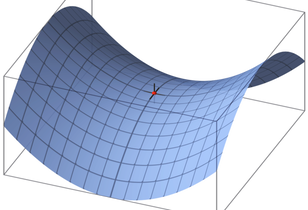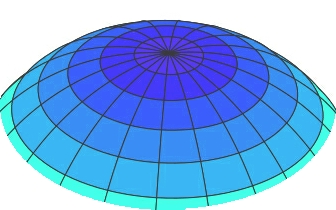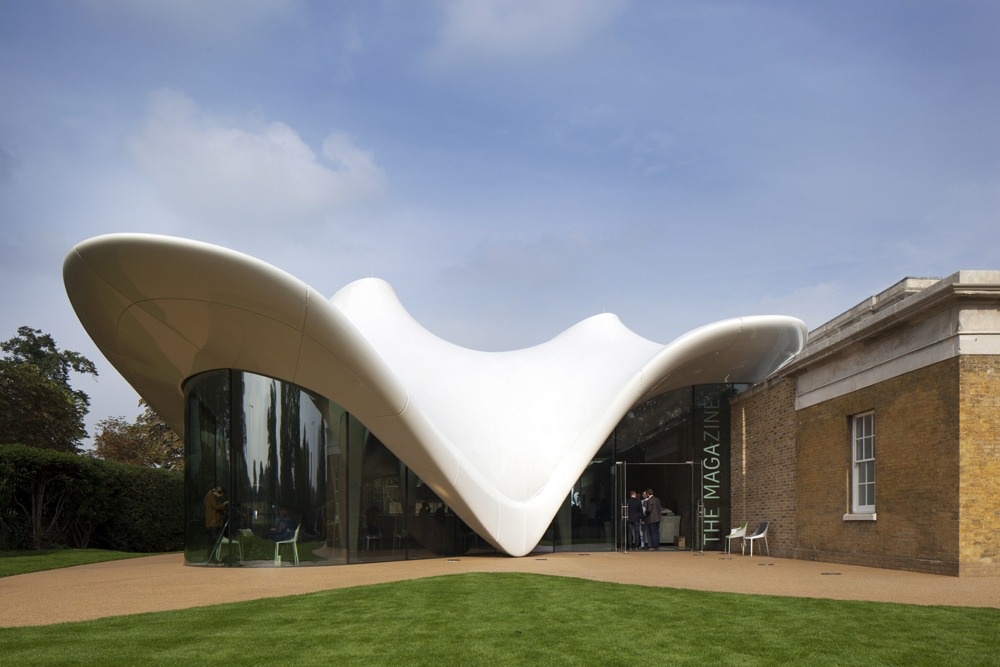Anticlastic structures
Tensile surfaces, that is, surfaces which carry only tension and no compression or bending, rely on double curvature for their stability. Stability is provided by the opposition of two curvatures which enable the surface to be tensioned without losing its form.
Tensioning the surface reduces its elasticity and so its tendency to deform under load, and the curvature itself means that the surface will deform less for any given extension.
Tensile surfaces can be used in buildings to create thin, long span enclosures, such as roofs for sports stadia, shopping centres, atria and so on. Typically they are constructed using a PVC coated polyester or PTFE coated glass fabric, typically just 1 mm thick.
Double curvature can be anticlastic or synclastic.

|

|
| Anticlastic (saddle-shaped). | Synclastic (dome-shaped) |
Anticlastic surfaces are those in which the centres of curvature are located on opposing sides of the surface. This is commonly-described as a saddle shape. A hyperbolic paraboloid is an anticlastic surface.
Synclastic surfaces are those in which the centres or curvature are on the same side of the surface. This is a dome-shape. This can be created with an architectural fabric by inflation – that is, air pressure within the dome maintains the form of the surface when it is tensioned, rather than the opposition of the curvatures.
[edit] Find out more
[edit] Related articles on Designing Buildings Wiki
- Barrel vault.
- Biaxial bending.
- Concept structural design of buildings.
- Conoid shell.
- Fabric structures.
- Hyperbolic paraboloid.
- Limit state design.
- Millennium Dome.
- Structural engineer.
- Synclastic.
- Tensegrity.
- Tensile structures.
- The development of structural membranes.
- The structural behaviour of architectural fabric structures.
- Types of dome.
[edit] External references
- ‘How structures work: Design and behavior from bridges to buildings’ (2nd ed.), YEOMANS, D., Wiley (2016)
Featured articles and news
The UK's Modern Industrial Strategy: A 10 year plan
Previous consultation criticism, current key elements and general support with some persisting reservations.
Building Safety Regulator reforms
New roles, new staff and a new fast track service pave the way for a single construction regulator.
Architectural Technologist CPDs and Communications
CIAT CPD… and how you can do it!
Cooling centres and cool spaces
Managing extreme heat in cities by directing the public to places for heat stress relief and water sources.
Winter gardens: A brief history and warm variations
Extending the season with glass in different forms and terms.
Restoring Great Yarmouth's Winter Gardens
Transforming one of the least sustainable constructions imaginable.
Construction Skills Mission Board launch sector drive
Newly formed government and industry collaboration set strategy for recruiting an additional 100,000 construction workers a year.
New Architects Code comes into effect in September 2025
ARB Architects Code of Conduct and Practice available with ongoing consultation regarding guidance.
Welsh Skills Body (Medr) launches ambitious plan
The new skills body brings together funding and regulation of tertiary education and research for the devolved nation.
Paul Gandy FCIOB announced as next CIOB President
Former Tilbury Douglas CEO takes helm.
UK Infrastructure: A 10 Year Strategy. In brief with reactions
With the National Infrastructure and Service Transformation Authority (NISTA).
Ebenezer Howard: inventor of the garden city. Book review.
The Grenfell Tower fire, eight years on
A time to pause and reflect as Dubai tower block fire reported just before anniversary.
Airtightness Topic Guide BSRIA TG 27/2025
Explaining the basics of airtightness, what it is, why it's important, when it's required and how it's carried out.
Construction contract awards hit lowest point of 2025
Plummeting for second consecutive month, intensifying concerns for housing and infrastructure goals.
Understanding Mental Health in the Built Environment 2025
Examining the state of mental health in construction, shedding light on levels of stress, anxiety and depression.






















